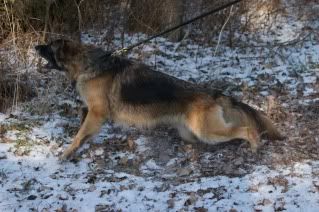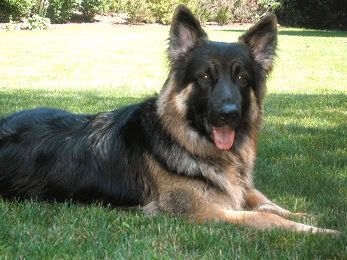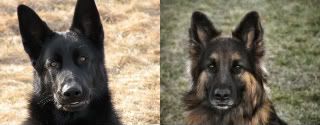 Body Language
#189577 - 04/10/2008 07:38 AM Body Language
#189577 - 04/10/2008 07:38 AM |
Webboard User
 
Reg: 09-22-2005
Posts: 979
Loc: New Jersey
 Offline Offline |
|
I thought I'd take advantage of the "Unstable" thread and put this question out there.
For argument's sake, let's pretend the OP (Aleida I believe) missed a signal from her dog just prior to his lunge/bite. I know from reading that she would be far from alone in missing this signal or signals.
Is it possible for those of you who are experts at canine body language to list for us those cues that present themselves just prior to a dog acting "aggressively"? I am not asking about the OP's situation. No one was there, so there is no way to tell what the dog presented. But is there a list of subtle things dogs have a tendency of doing just prior to a situation (whatever that situation is)?
I.E. an momentary stare, a muscle twitch, an ear placement, a tail movement, etc.????
I have a wolf book that shows a pic of two wolves confronting each other with the dominant wolf "taking an aggressive stand". But he has his ears to the side. Is this ear placement what we would look for in ours dogs?? I thought the ear placement would be forward if they are about to be aggressive  .
Anything you guys can list, especially the subtle cues, would be so helpful for those of us who don't know what to look for.
Judy
|
 Top Top
|
 Re: Body Language
[Re: Judy Troiano ]
#189584 - 04/10/2008 07:54 AM Re: Body Language
[Re: Judy Troiano ]
#189584 - 04/10/2008 07:54 AM |
Webboard User
  
Reg: 06-11-2005
Posts: 398
Loc:
 Offline Offline |
|
I pondered about this question and instinctively my awnser was:" You "feel" it " After thinking about the times he went for another dog i came to these points
tension of muscles
little crouching he becomes a few cm smaller
And this is due to training; He will seek body contact with me( during our training we try to sneek away from our dogs when they are focussed on the decoy and when we succeed they get corrected for "not staying in contact with the handler". So now when he is realy focused on something he will put his hindquarters against my leg and push so i can't sneek away. )
No raising of hairs or showing teeth. Simply preparing his body for an attack.
Greetings
Johan
|
 Top Top
|
 Re: Body Language
[Re: Johan Engelen ]
#189585 - 04/10/2008 08:05 AM Re: Body Language
[Re: Johan Engelen ]
#189585 - 04/10/2008 08:05 AM |
Webboard User
  
Reg: 08-05-2007
Posts: 323
Loc: Lake City, Coeur d' Alene, ID
 Offline Offline |
|
I believe Leerburg sells a good book on all types of canine body language. It's got lots of pictures.
It's title is Canine Body Language, duh
Lee Sternberg |
 Top Top
|
 Re: Body Language
[Re: Judy Troiano ]
#189588 - 04/10/2008 08:12 AM Re: Body Language
[Re: Judy Troiano ]
#189588 - 04/10/2008 08:12 AM |
Webboard User

  
Reg: 04-19-2005
Posts: 505
Loc: Mid Missouri USA
 Offline Offline |
|
In my experience, the one main give away that aggression or attack is imminent is that the dog goes "still", they don't move, they don't blink. They are usually looking at the target of their aggression, but not necessarily straight-on, sometimes out of the corner of their eyes. This can last for awhile, or only a split second. This is what I've seen in my dogs, and I can catch that sudden "stillness" even if I'm not looking directly at my dogs now, and interrupt them immediately.
Janice Jarman |
 Top Top
|
 Re: Body Language
[Re: Janice Jarman ]
#189593 - 04/10/2008 08:35 AM Re: Body Language
[Re: Janice Jarman ]
#189593 - 04/10/2008 08:35 AM |
Webboard User
  
Reg: 08-16-2007
Posts: 2365
Loc: Toronto, Ontario, Canada
 Offline Offline |
|
well, you all know i'm still trying to figure this out myself. it'd be so easy if teagan had more obvious body language or would vocalize, but then, i wouldn't be learning as much as i am with her.
i agree with janice - teagan has a sudden, very quick, stillness - sometimes it's almost midstep, but it's like she suddenly holds herself or her breath right before she goes.
her breathing pattern also changes and she will breathe more heavily.
if she's being half-hearted, she does give the more obvious body language - she'll quickly look at the dog before turning away, though she's obviously still listening and aware of all movement etc in the direction of the dog, and then she'll try to go (though this is the easiest to stop, obviously).
i definitely wasn't able to pick up on all these signals immediately after getting her. now, i see them a lot more, b/c i know to look for them, and i've spent so much time observing her. i'm sure different dogs will display some signals more than others, so i would guess it's also a matter of getting to know your dog.
Teagan!
 |
 Top Top
|
 Re: Body Language
[Re: lee sternberg ]
#189596 - 04/10/2008 08:43 AM Re: Body Language
[Re: lee sternberg ]
#189596 - 04/10/2008 08:43 AM |
Webboard User
 
Reg: 09-22-2005
Posts: 979
Loc: New Jersey
 Offline Offline |
|
I believe Leerburg sells a good book on all types of canine body language. It's got lots of pictures.
It's title is Canine Body Language, duh
I should take a look at it but here's what is a little confusing for me:
the book I am looking at now has beautiful, clear pics of wolves in various states of aggression. In one the wolf is baring its teeth but his ears are clearly forward and upright. In another picture a different wolf is doing the same thing (snarling) but his ears are to the side.
Do the position of the ears during a snarl signify the wolf's role in the heirarchy maybe? I.E. a dominant wolf would have his ears to the side in a snarl but a submissive wolf would have his ears upright and forward in a snarl?? 
I'm assuming I can take these pics of wolves and apply them to dogs, thereby helping me to understand a potential stray wandering toward us. If he is snarling at my dog as he's approaching but his ears are forward, does that make him submissive somehow  ?
I'm totally confused  .
Edited to add to the confusion; if a dog's hackles are up, does this automatically mean something standard across the board - whenever a dog hackles up, it means it is scared? Or whenever a dog hackles up it means it's being aggressive?
|
 Top Top
|
 Re: Body Language
[Re: Judy Troiano ]
#189616 - 04/10/2008 10:02 AM Re: Body Language
[Re: Judy Troiano ]
#189616 - 04/10/2008 10:02 AM |
Webboard User
  
Reg: 08-30-2007
Posts: 3283
Loc:
 Offline Offline |
|
For me it seems more of an instinct, then actually thinking about the presented body language. Knowing ones own dog/s is a big part of it, i.e. you're aware of what your dog reacts to. Beyond that, for me it's just something I've internalized so much. To say it's; the set of the ears, the position of the tail, the way the head is carried, the tense of the muscles, the look the the eyes, how the mouth is held, or any other small part of the language is to miss the bigger picture.
What is the dogs intent? Focussing on just the eyes or ears, etc is like trying to study a forest by looking at just one tree, somethings can be gleaned from one tree, but the forest will remain be a mystery until it's studied and felt in the larger context.
Besides over the years I've learned that if I stop to think about what the dog's intent is, it's to late to do anything about it. So I operate pretty much on autopilot all the time.
Sometimes just the turning of the head puts me on alert, are there other clues I don't mentally note? Very likely, but I wouldn't be able to say what they were or are.
If I'm not learning, I'm not paying attention.
Randy
Ps.
Have I sufficiently muddied the waters? LOL
|
 Top Top
|
 Re: Body Language
[Re: randy allen ]
#189628 - 04/10/2008 10:22 AM Re: Body Language
[Re: randy allen ]
#189628 - 04/10/2008 10:22 AM |
Moderator

   
Reg: 01-25-2003
Posts: 5983
Loc: Idaho
 Offline Offline |
|
Excellent post by Randy.
And I'm in agreement with him, I think you learn to read dogs gradually over time, it's very experience based. Eventually it becomes second nature and you don't have to think about it, but this ability comes with time and constant exposure to canine behaviors. You can't really learn it from a book.
As an example, this topic is one of the reasons that I see that so many dog training schools just suck, the students graduate with only minimal true experience handling dogs, if you get right down to it - and the ability to read dogs is a vital tool for a professional dog trainer.
|
 Top Top
|
 Re: Body Language
[Re: Will Rambeau ]
#189648 - 04/10/2008 10:59 AM Re: Body Language
[Re: Will Rambeau ]
#189648 - 04/10/2008 10:59 AM |
Webboard User
 
Reg: 09-22-2005
Posts: 979
Loc: New Jersey
 Offline Offline |
|
Excellent post by Randy.
And I'm in agreement with him, I think you learn to read dogs gradually over time, it's very experience based. Eventually it becomes second nature and you don't have to think about it, but this ability comes with time and constant exposure to canine behaviors. You can't really learn it from a book.
As an example, this topic is one of the reasons that I see that so many dog training schools just suck, the students graduate with only minimal true experience handling dogs, if you get right down to it - and the ability to read dogs is a vital tool for a professional dog trainer.
So if you'll allow me clarify; I do understand the "get it" comment and that comes with time experiencing dogs and that comes with time understanding your particular dog.
Does this "get it" concept also apply when you're dealing with strange dogs that are not in a seminar, or any controlled environment? A loose dog coming up to you and Fetz or to you Randy when you're walking with Cassie? Is there body language that you witness with your eyes that give you clues that the oncoming dog may be DA, fearful, playful, whatever.
I'm struggling with the "get it" part because too often a dog comes out of the blue when I'm walking my dog and I just don't know enough about body language to make an educated guess as to the intentions of the dog. So I pray instead  !!
The other night I was walking my dog in the middle of a street in a quiet suburban area. As I was passing one particular house, the lab in the yard spotted us and began walking toward us. I was hoping he had an electric fence but NO, it didn't and the owner was no where to be found.
The moment it stepped off the property, it was within 5 feet of us. I found it hard to keep him away from Gunnar. He turned out to be friendly. My question; would his body language as he was walking toward us have told me something about his intentions? Position of ears, anything?
|
 Top Top
|
 Re: Body Language
[Re: Judy Troiano ]
#189655 - 04/10/2008 11:07 AM Re: Body Language
[Re: Judy Troiano ]
#189655 - 04/10/2008 11:07 AM |
Moderator

    
Reg: 07-14-2001
Posts: 2069
Loc: Wisconsin
 Offline Offline |
|
|
 Top Top
|
When purchasing any product from Leerburg Enterprises, Inc. it is understood
that any and all products sold by Leerburg Enterprises, Inc. are sold in Dunn
County Wisconsin, USA. Any and all legal action taken against Leerburg Enterprises,
Inc. concerning the purchase or use of these products must take place in Dunn
County, Wisconsin. If customers do not agree with this policy they should not
purchase Leerburg Ent. Inc. products.
Dog Training is never without risk of injury. Do not use any of the products
sold by Leerburg Enterprises, Inc. without consulting a local professional.
The training methods shown in the Leerburg Ent. Inc. DVD’s are meant
to be used with a local instructor or trainer. Leerburg Enterprises, Inc. cannot
be held responsible for accidents or injuries to humans and/or animals.
Copyright 2010 Leerburg® Enterprises, Inc. All rights reserved. All photos and content on leerburg.com are part of a registered copyright owned by Leerburg Enterprise, Inc.
By accessing any information within Leerburg.com, you agree to abide by the
Leerburg.com Privacy Policy and Terms of Use.
 Previous Topic
Previous Topic Index
Index Next Topic
Next Topic












 .
.
 Top
Top


 !!
!!



